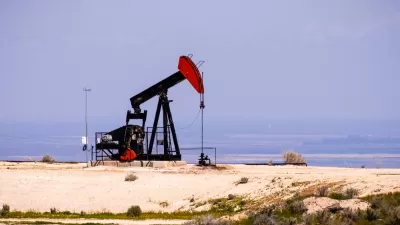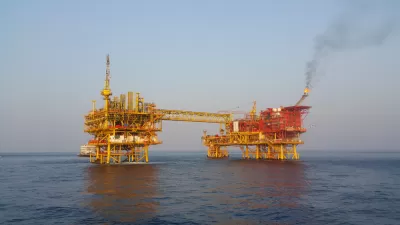Gas prices will drop due to surging U.S. oil production according to an U.S. Energy Dept. report. Another report from the International Energy Agency points to surging carbon dioxide emissions, not from oil but from coal burning, largely from China.
Clifford Krauss and Stanley Reed write about two reports released Dec. 16 that give hard data on energy production in both the U.S. and the world, and what it means for world energy prices and climate change.
In short, growing U.S. oil production is projected to lower world oil prices while growing coal consumption, particularly from China, have caused 60 percent of the increase in global carbon dioxide emissions since 2000, and coal "consumption through 2018 is expected to increase by 2.3 percent a year." Details follow.
The first report is from the U.S. Energy Department's information gathering division, the Energy Information Administration or EIA.
The Annual Energy Outlook 2014 (AEO2014) Early Release Overview (PDF) "predicted that the increase in United States (oil) production [an average of 800,000 barrels a day annually through 2016] would contribute to a decline in the world oil benchmark price over the next few years to $92 a barrel in 2017 from a 2012 average of $112 a barrel, which should translate into lower prices at the pump for consumers."
Krauss and Reed point to the regional "glut of certain higher grades of oil...in the Midwest and Gulf States" that is "stir(ring) a debate in Washington over whether the Obama administration should reverse a policy of banning most exports of oil that goes back to the 1970s", also discussed here on Dec. 17.
Also covering EIA's annual outlook, NPR in a recent broadcast noted that "the United States became the world's biggest producer of oil and natural gas" and discussed how this "transformational event" will affect the development of renewable energy.
The somber report from the Paris-based International Energy Agency indicates that "global consumption of coal, a major source of the greenhouse gases blamed for rising global temperatures and other pollutants, is likely to continue to grow at 'a relentless pace' through 2018."
The agency said that the consumption of coal for electricity generation and heat accounted for more than three-fifths of the rise in global carbon dioxide emissions since 2000. Coal use increased by an average of 3.4 percent per year from 2007 to 2012, faster than the increase in either oil or natural gas. Consumption through 2018 is expected to increase by 2.3 percent a year, the I.E.A. said.
"China will account for nearly 60% of new global (coal) demand over the next five years," states the IEA press release. A major source of China's coal demand will be for "gasification", unlike the U.S. process that uses hydraulic fracturing and horizontal drilling in shale basins. How the production of "synthetic gas" affects carbon emissions was posted here in September.
Coal growth in the U.S., on the other hand, is on the opposite trajectory largely due to the use of fracking in shale basins. While coal burning has grown in the past year, accounting for "40% or more of the nation's electricity...with natural gas fueling about 25% of generation during the same period" according to the E.I.A. May 23 report, the annual outlook projects that natural gas production will see "a 56% increase between 2012 and 2040."
The result: "In 2040, natural gas accounts for 35% of total electricity generation, while coal accounts for 32% (Figure 3 on page 2)." [PDF]
FULL STORY: Surge Seen in U.S. Oil Output, Lowering Gasoline Prices

Study: Maui’s Plan to Convert Vacation Rentals to Long-Term Housing Could Cause Nearly $1 Billion Economic Loss
The plan would reduce visitor accommodation by 25,% resulting in 1,900 jobs lost.

North Texas Transit Leaders Tout Benefits of TOD for Growing Region
At a summit focused on transit-oriented development, policymakers discussed how North Texas’ expanded light rail system can serve as a tool for economic growth.

Why Should We Subsidize Public Transportation?
Many public transit agencies face financial stress due to rising costs, declining fare revenue, and declining subsidies. Transit advocates must provide a strong business case for increasing public transit funding.

How to Make US Trains Faster
Changes to boarding platforms and a switch to electric trains could improve U.S. passenger rail service without the added cost of high-speed rail.

Columbia’s Revitalized ‘Loop’ Is a Hub for Local Entrepreneurs
A focus on small businesses is helping a commercial corridor in Columbia, Missouri thrive.

Invasive Insect Threatens Minnesota’s Ash Forests
The Emerald Ash Borer is a rapidly spreading invasive pest threatening Minnesota’s ash trees, and homeowners are encouraged to plant diverse replacement species, avoid moving ash firewood, and monitor for signs of infestation.
Urban Design for Planners 1: Software Tools
This six-course series explores essential urban design concepts using open source software and equips planners with the tools they need to participate fully in the urban design process.
Planning for Universal Design
Learn the tools for implementing Universal Design in planning regulations.
City of Santa Clarita
Ascent Environmental
Institute for Housing and Urban Development Studies (IHS)
City of Grandview
Harvard GSD Executive Education
Toledo-Lucas County Plan Commissions
Salt Lake City
NYU Wagner Graduate School of Public Service




























